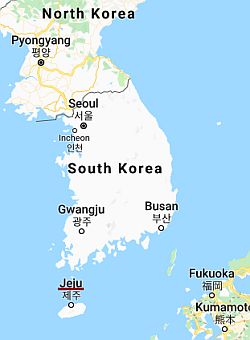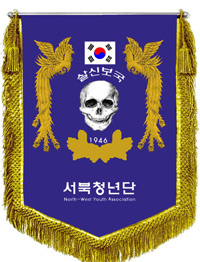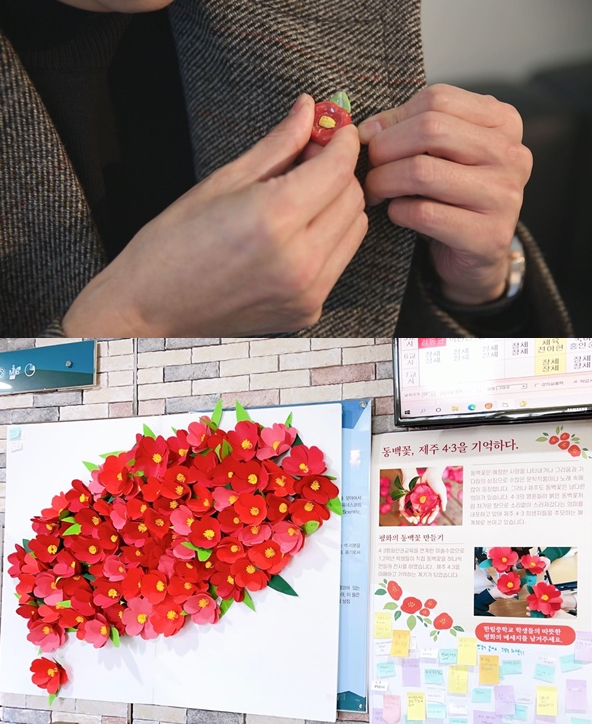More languages
More actions
This article is in the process of being expanded from Republic of Korea#Jeju Uprising and Massacre.

The Jeju uprising, known in Korean as the Jeju April 3 incident (Korean: 제주 4·3 사건), was an uprising that occurred in the Korean island of Jeju from April 1948 to May 1949. Residents of Jeju opposed to the division of Korea and were eventually violently suppressed by the South Korean government and right-wing paramilitary groups in a scorched-earth operation, resulting in a massacre that took an estimated 30,000 lives, or one-tenth of the island's population,[1] as well the arrest and, in some cases, decades-long imprisonment of many of the island's residents.[2] The Jeju massacre is the second largest massacre in South Korea's modern history.[3] The facts of the Jeju massacre were officially suppressed for over fifty years, only coming to light in January 2000 when a Special Act was decreed by the South Korean Government calling for an official investigation of the incident.
Background
After Korea's liberation from Japanese colonization, the Jeju People’s Committee was formed with the head of the Farmers Guild and the Fishermen’s Guide as its leaders. Peoples' Committees formed throughout the Korean Peninsula and enjoyed widespread support. However, the U.S. military government in Korea (USAMGIK) did not recognize their legitimacy and began to forcibly dismantle them. According to the Jeju 4.3 Peace Foundation, "In every aspect, the Jeju People’s Committee was the only political party and the only government in Jeju" after liberation from the Japanese, and E. Grant Meade, a USAMGIK officer, said, “The Jeju People’s Committee was the only political party in the island and the only organization acting like a government.”[4] The committees had the respect and support from most villagers. Committee members were known in their communities from their long years as school teachers, union leaders and for resistance to Japanese abuses or for their organizing work in Japan.[5]
When the USAMGIK arrived on Jeju, it found that the Jeju People’s Committee and all the village and county People’s Committees were functioning successfully as a de facto government with popular support. The USAMGIK did not disturb or challenge this de facto government, which was unusual because the USAMGIK had as its mission to insure that a right leaning government hostile to socialism emerged in Korea,[5] and had already struck down other People's Committees throughout South Korea by this time. Unlike in the mainland, where the People's Committees were immediately disregarded and systematically dismantled by the USAMGIK, the People's Committee on Jeju Island remained intact for a longer period, serving as the island's main governmental body until 1948 when it, too, was violently dismantled in conjunction with the process of the Republic of Korea being officially established that year.
People's opposition to the division of Korea

Many Jeju islanders resisted the division of the Korean Peninsula and strongly protested the first election that was scheduled for May 10, 1948, that would confirm the formation of the Republic of Korea south of the 38th parallel. Fearing that the elections would further reinforce Korea's division, guerrilla fighters of the Workers' Party of South Korea attacked local police and rightist youth groups stationed on Jeju Island. Their resistance to the division of the peninsula and the establishment of the Southern regime triggered a brutal suppression by government and right-wing paramilitary forces, which not only targeted communists known to have participated in the rebellion, but imposed its deadly measures on virtually the entire citizenry of Jeju island.
Jeju massacre
According to The Jeju 4·3 Incident Investigation Report, "In around the middle of November 1948, uncompromising repression operations were carried out. Under these operations, a curfew was imposed on the residents of the upland areas and if anyone broke it, he or she was executed without exception. From the middle of November 1948 to February 1949, for about four months, the anti-guerrilla expeditions burned down the upland villages and killed the residents collectively. [...] During this period, the casualties were the highest and most of the upland villages were literally burnt to the ground."[6] A combination of government forces and violent far-right paramilitary groups, notably the far-right anti-communist Northwest Youth League, carried out these attacks.[7]
Death toll of Jeju massacre

Because the facts of the Jeju massacre were officially suppressed for over fifty years, only coming to light in January 2000 when a Special Act was decreed by the South Korean Government calling for an official investigation of the incident, an official death toll could not be established until that time. Additionally, discoveries of mass grave execution sites, such as the one uncovered in 2008 near Jeju Airport,[3] illustrate the difficulty of calculating the massacre's true toll. According to a report by the National Commission on the Jeju April 3 Incident, 25,000 to 30,000 people were killed or simply vanished, with upwards of 4,000 more fleeing to Japan as the government sought to quell the uprising. As the island’s population was at most 300,000 at the time, the official toll was one-tenth of the inhabitants. However, some Jeju people claim that as many as 40,000 islanders were killed in the suppression.[3] Other estimates claim as many as 60,000 people may have been killed by the end of these events.[8] The 30,000 death figure, or one in every 10 Jeju residents at the time, is a common figure given for how many people lost their lives during this period, and is the one cited on the Jeju 4.3 Peace Foundation website.[1]
Long-term imprisonment of Jeju islanders
One result of the decades-long suppression of the facts of the massacre is the long-term imprisonment of Jeju islanders arrested on suspicion of being communists during the conflict. Many of those arrested on these charges died in captivity. Others remained in prison for up to 20 years, and those who had been released were not cleared of their criminal records, and were ostracized by the community or disadvantaged in their job applications for having criminal records. Decades after being arrested, some of the remaining victims had their names legally cleared of the charges in 2019, due to a ruling that found that the military court of the time did not follow proper legal procedures, made groundless charges, and that there were no court records found from the time explaining why those arrested were given such harsh sentences.[2]
References
- ↑ 1.0 1.1 "Background to the Jeju 4·3 Uprising and Massacre" (2018). Jeju 4.3 Peace Foundation. Archived from the original on 2022-07-23.
- ↑ 2.0 2.1 “The suit was filed by 18 plaintiffs who were jailed after being branded as communist insurgents ― with around 2,500 others ― during the ideological conflict that flared up on the southern island after Korea's independence from Japan. Many died in captivity. Even after surviving the massacre and imprisonment, the plaintiffs were ostracized by the community or disadvantaged in their job applications for having criminal records. [...] The plaintiffs demanded a retrial in 2017, saying they were arrested and imprisoned for up to 20 years without fair procedure. There were no court records found from the time explaining why the plaintiffs were given such harsh sentences.”
Lee Suh-yoon (2019-01-17). "Jeju massacre victims get their names cleared in court" The Korea Times. - ↑ 3.0 3.1 3.2 Song Jung Hee (2010-03-31). "Islanders still mourn April 3 massacre" The Jeju Weekly.
- ↑ "Jeju’s political climate following liberation" (2018). Jeju 4.3 Peace Foundation. http://jeju43peace.org/historytruth/fact-truth/factstruth_article4/
- ↑ 5.0 5.1 Jay Hauben (2011-08-20). "People's Republic of Korea: Jeju, 1945-1946" The Jeju Weekly. Archived from the original on 2022-07-23. Retrieved 2022-07-23.
- ↑ Jeju 4·3 Peace Foundation (2003). The Jeju 4·3 Incident Investigation Report (p. 469). The National Committee for Investigation of the Truth about the Jeju April 3 Incident.
- ↑ ““Despite the Northwest Youth League lacking legal backing to exercise their power, President Rhee and the KDP allowed the group to use aggressive force against supposed Communists without restrictions. [...] Professor Bruce Cumings of the University of Chicago states that at the time, Jeju’s local government and police were comprised mostly of mainlanders who “worked together with ultra-rightest party terrorists,” otherwise known as the Northwest Youth League.””
Lauren Flenniken (2011-04-10). "The Northwest Youth League" The Jeju Weekly. - ↑ Ghosts of Cheju (2000-06-18). Newsweek. Archived from the original. Retrieved 2021-21-30.
